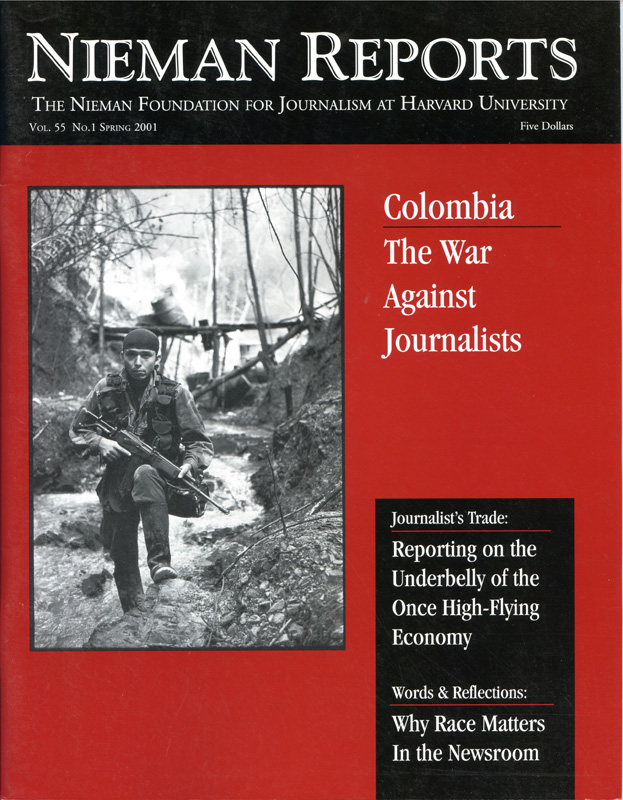The media have gone to sleep on America’s poor. The silence is not total, to be sure, and I can hardly claim to be aware of everything that is published or aired. Stories appear all the time about individual successes or heartbreaking situations and whether homeless shelters and soup kitchens are serving more people this winter than they did last year. But I’ve observed relatively few journalists who try to portray patterns when it comes to coverage of poverty or who skillfully weave questions about policy into their reporting on people’s lives.
The most obvious dereliction is in the coverage of the 1996 welfare law, although stories about poverty ought to be about much more than just welfare. Most Americans believe the law has been a huge success. Undoubtedly many base their views on information they’ve been presented; perhaps the most oft-repeated statistic is the one reporting that welfare rolls have been cut by more than 50 percent since their high point in 1994.
Yet that piece of information actually tells only a small part of the story. There are dozens of stories about, or connected with, the developments in welfare policy during the past five years. For example, of those who left welfare, how many still have a job? It turns out to be a lower percentage than one might think. There has been a major increase in the number of single mothers who are working, but research shows that only about three out of five who have left welfare actually have a job. These figures suggest a deeply troubling story, but it goes almost totally unreported.
Among those who are working, not many are managing to escape poverty. The average wage paid to former welfare recipients is seven dollars an hour, and they work an average of 30 hours per week. Using the Earned Income Tax Credit, a single mother who earns $10,000 in salary and has one or two children will get out of poverty (although this assumes that the poverty line is a meaningful measure of a decent standard of living). But for about half of these women, there are either too few hours of work or too low a wage paid, or both, to help them get out of poverty. Additionally, many of these women lost their food stamps or their Medicaid (health insurance) or both, even though the law explicitly states that this shouldn’t happen when they leave welfare.
Some of the most important questions in the coverage of poverty today are ones that begin with the word “why.” Why is there so much low-wage work in an economy that has been so strong? Why is there so much part-time work when people want and need full-time jobs? Why have so many former welfare recipients lost their food stamps and Medicaid? Why is the poverty line defined as $14,000 for a family of three? There are other important issues that journalists could also do a better job of tracking. What does it actually cost for a family to survive? And what does “survival” look like in terms of daily life? What approaches could be tried to respond to challenges raised by such questions?
When was the last time you read, viewed or heard a well reported story addressing these issues? Or read an article informing you that the poorest 10 percent of single mothers have lost income during the past four years because they have lost more in benefits than they have gained in earnings? Or seen a story in which a reporter explored ways in which states’ various policies have produced different outcomes? If a state uses private and/or faith-based contractors to deliver services, are they performing well? Are they adhering to constitutional obligations? And can journalists even get the kind of access to vital records that the public ought to expect from these private companies?
These are stories waiting to be told, along with those that will help us understand more about what is about to happen as time limits take assistance away from large numbers of families. The list of possible stories goes on. How does poverty affect children? What does a single mother do about care for her children when her work hours are from four until midnight, a time when little child care is available? Or what does she do when her child is sick? Or if she has an infant and is required to go to work, what happens when she can not locate an affordable infant care slot?
The 1996 welfare law expires in 2002. During the next year, debate will begin in Congress about its reauthorization. Energetic reporting about the experience so far, from perspectives rooted in personal experience and policy approaches, would be extremely useful in informing the public in preparation for this debate.
But issues revolving around poor and low-wage workers aren’t only about welfare. Even though there are crises in affordable rental housing in nearly every big city in America, very few stories about this situation seem to be emerging. Then there are issues that are covered well by some journalists and news organizations but still lack consistent and comprehensive reporting that reaches the general public. Among these are critical topics such as racial discrimination, the increasing lack of health insurance, the safety of some child-care arrangements, foster care and child protection, and schools that serve predominantly poor children.
The totality of this pattern is, in fact, greater than the sum of its parts. What such reporting would reveal is a structural problem, one that currently doesn’t receive the media attention it deserves. This wealthy country of which we are so proud is, in reality, two nations. Out of embarrassment, shame or indifference, we, who live in one part of this nation, have tended to shove the residents of the second out of sight. Journalists could do a much better job reminding us of who we are supposed to be.
Peter Edelman is a professor of law at Georgetown University Law Center. He was assistant secretary of health and human services in the Clinton Administration and is the author of “Searching for America’s Heart: RFK and the Renewal of Hope” (Houghton Mifflin, 2001).
The most obvious dereliction is in the coverage of the 1996 welfare law, although stories about poverty ought to be about much more than just welfare. Most Americans believe the law has been a huge success. Undoubtedly many base their views on information they’ve been presented; perhaps the most oft-repeated statistic is the one reporting that welfare rolls have been cut by more than 50 percent since their high point in 1994.
Yet that piece of information actually tells only a small part of the story. There are dozens of stories about, or connected with, the developments in welfare policy during the past five years. For example, of those who left welfare, how many still have a job? It turns out to be a lower percentage than one might think. There has been a major increase in the number of single mothers who are working, but research shows that only about three out of five who have left welfare actually have a job. These figures suggest a deeply troubling story, but it goes almost totally unreported.
Among those who are working, not many are managing to escape poverty. The average wage paid to former welfare recipients is seven dollars an hour, and they work an average of 30 hours per week. Using the Earned Income Tax Credit, a single mother who earns $10,000 in salary and has one or two children will get out of poverty (although this assumes that the poverty line is a meaningful measure of a decent standard of living). But for about half of these women, there are either too few hours of work or too low a wage paid, or both, to help them get out of poverty. Additionally, many of these women lost their food stamps or their Medicaid (health insurance) or both, even though the law explicitly states that this shouldn’t happen when they leave welfare.
Some of the most important questions in the coverage of poverty today are ones that begin with the word “why.” Why is there so much low-wage work in an economy that has been so strong? Why is there so much part-time work when people want and need full-time jobs? Why have so many former welfare recipients lost their food stamps and Medicaid? Why is the poverty line defined as $14,000 for a family of three? There are other important issues that journalists could also do a better job of tracking. What does it actually cost for a family to survive? And what does “survival” look like in terms of daily life? What approaches could be tried to respond to challenges raised by such questions?
When was the last time you read, viewed or heard a well reported story addressing these issues? Or read an article informing you that the poorest 10 percent of single mothers have lost income during the past four years because they have lost more in benefits than they have gained in earnings? Or seen a story in which a reporter explored ways in which states’ various policies have produced different outcomes? If a state uses private and/or faith-based contractors to deliver services, are they performing well? Are they adhering to constitutional obligations? And can journalists even get the kind of access to vital records that the public ought to expect from these private companies?
These are stories waiting to be told, along with those that will help us understand more about what is about to happen as time limits take assistance away from large numbers of families. The list of possible stories goes on. How does poverty affect children? What does a single mother do about care for her children when her work hours are from four until midnight, a time when little child care is available? Or what does she do when her child is sick? Or if she has an infant and is required to go to work, what happens when she can not locate an affordable infant care slot?
The 1996 welfare law expires in 2002. During the next year, debate will begin in Congress about its reauthorization. Energetic reporting about the experience so far, from perspectives rooted in personal experience and policy approaches, would be extremely useful in informing the public in preparation for this debate.
But issues revolving around poor and low-wage workers aren’t only about welfare. Even though there are crises in affordable rental housing in nearly every big city in America, very few stories about this situation seem to be emerging. Then there are issues that are covered well by some journalists and news organizations but still lack consistent and comprehensive reporting that reaches the general public. Among these are critical topics such as racial discrimination, the increasing lack of health insurance, the safety of some child-care arrangements, foster care and child protection, and schools that serve predominantly poor children.
The totality of this pattern is, in fact, greater than the sum of its parts. What such reporting would reveal is a structural problem, one that currently doesn’t receive the media attention it deserves. This wealthy country of which we are so proud is, in reality, two nations. Out of embarrassment, shame or indifference, we, who live in one part of this nation, have tended to shove the residents of the second out of sight. Journalists could do a much better job reminding us of who we are supposed to be.
Peter Edelman is a professor of law at Georgetown University Law Center. He was assistant secretary of health and human services in the Clinton Administration and is the author of “Searching for America’s Heart: RFK and the Renewal of Hope” (Houghton Mifflin, 2001).




